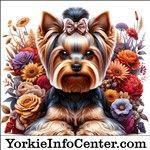Yorkshire Terrier vs Silky Terrier
The Yorkshire Terrier vs the Silky Terrier
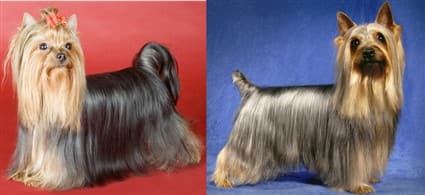
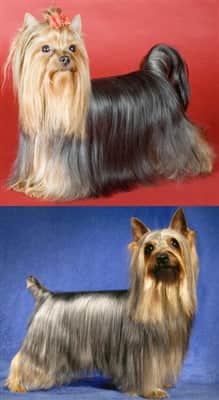
Overview
If you think that these two breeds look very similar, you’re correct; they are considered close cousins. On the left (top on mobile) is the Yorkshire Terrier and on the right (bottom on mobile) is the Silky Terrier. This article will cover the similarities, differences, and interesting common bloodlines of these two toy breeds.
Linked Bloodlines
The Yorkshire Terrier
was developed in England, the Yorkshire and Lincolnshire regions of England, to be exact. During the 1800’s, people immigrating from Scotland to England, mainly to find work in the many cotton and wool mills, brought along a wide variety of small terrier dogs including the Clydesdale Terrier, Paisley Terrier, and Skye Terrier. In general, all of these different breeds were dubbed ‘Scottish Terriers’ (not to be confused with today's Scottish Terrier).
Over the years, those dogs were bred to the English Waterside Terrier and some also believe to some extent to the Maltese. And, over time, a consistent appearance started to appear; color was becoming predictable with blue and gold (or black and tan) and these dogs were placed into a breed class called ‘Rough and Broken-coated, Broken-haired Scotch and Yorkshire Terriers’
Yorkies were known for being ‘ratters’ (chasing after vermin in mills and in mines) and for being taken on hunts to chase down small forest animals including fox and badgers.
As time passed, Yorkshire Terriers were being bred to Yorkshire Terriers with less influence from outside breeds and were becoming even more distinct. Size was becoming more consistent, due in large part to a Yorkie named Huddersfield Ben that won 74 show ring prizes and reliably sired dogs that were under 7 lbs.
Toward the end of the 1800’s, there was a change in status from hunting/ratting dog to companion dog. And, in 1872, Yorkies started appearing in the US, with the AKC officially recognizing the Yorkshire Terrier breed in 1885.
The Silky Terrier, also known as the Australian Silky Terrier, was developed in Australia, through the pairing of the Yorkshire Terrier and the Australian Terrier in the early to mid-1800’s. The Australian Terrier (also a ‘ratter’ like the Yorkie) is known for having a very rough coat which was overshadowed by the introduction of the Yorkie’s silky coat.
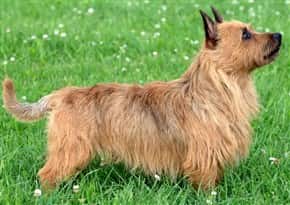
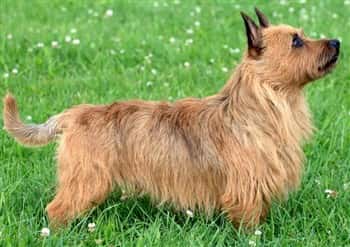
An Australian Terrier, the Silky Terrier's other parent breed
These first pairings happened in Sydney, Australia, so at that time this newly developing breed was dubbed the Sydney Silky.
For quite some time the Sydney Silky, the Yorkshire Terrier, and the Australian Terrier were interbred with no real distinction. But this changed in 1929 when cross-breeding was discouraged and the breed’s name was changed to the Australian Silky Terrier to reflect this. The AKC officially recognized the Silky Terrier (opting to drop the ‘Australian’ from the name) in 1959 which is much later than the Yorkshire Terrier’s acceptance in 1885.
Yorkshire Terrier and Silky Terrier Side-by-Side Comparison
Note that these stats are based on the AKC’s breed standards that describe the ideal show dog. Pet Yorkies and Silkies have variations including color, size, and more. Stats are for the Yorkshire Terrier first, followed by the Australian Silky Terrier.
Group:
Toy | Toy
Weight:
Not to exceed 7 lbs. | No official weight, but usually around 10 lbs.
Height:
No official height, but usually 8 to 9 inches at the shoulder | 9 to 10 inches
Bite set:
Scissors bite (when the incisor teeth in the upper jaw are in contact with but slightly overlap those in bottom jaw) or level bite (the incisor teeth meet exactly, surface to surface) | Scissors bite
Head:
Small and rather flat on top| Strong, wedge-shaped, and moderately long. Stop is shallow.
Skull:
Not too prominent or round | Flat, not too wide between the ears
Muzzle:
Not too long | Skull is slightly longer than muzzle
Eyes:
Medium in size and not too prominent; dark in color and sparkling with a sharp, intelligent expression | Small, dark, almond shaped with dark rims.
Ears:
Small, v-shaped, carried erect, and set not too far apart | Small, v-shaped, set high, and carried erect without tendency to flare obliquely off the skull
Nose:
Black | Black
Let’s stop here for a moment to look at the head and facial structures of the Yorkshire Terrier vs the Silky Terrier, since this is one of the most noticeable variances. And, since both breeds can look extremely different when having a short coat vs a long coat and long hairs can disguise true face shapes, we’ll take a look at both dogs with short puppy trims.
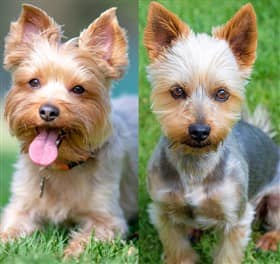

The Yorkshire Terrier is on the left, the Silky Terrier is on the right. And, you’ll notice that the Silky Terrier does indeed have a more ‘wedge-shaped’ head as called out in the breed standard with a slightly longer skull. The forehead on the Silky (not mentioned in the breed standard) is narrower. In addition, the Silky has a slightly broader, thicker, and longer muzzle.
Another feature to take note of is the stop (the angle of change between the muzzle and the forehead); though the AKC breed standard does not mention the Yorkie’s stop, it is a moderate stop and the Silky has a shallow stop.
There is very little in the breed standards that describe the nose of these breeds; for both it is simply ‘black’. However, most Silky Terriers tend to have somewhat more prominent noses than Yorkshire Terriers.
Color Differences
At first glance, it may appear that both of these breeds hold the same colors; however, the Silky Terrier has more color range than the Yorkie.
The Yorkshire Terrier has only 4 accepted color combinations: Black & Gold (S 234), Black & Tan (S 018), Blue & Gold (S 041), and Blue & Tan (S 044). Puppies are born black and tan though there may be very little tan (sometimes just a few stray hairs). The black transitions to blue as a Yorkie matures. In the show ring, the blue is expected to be a dark steel-blue, not a grayish or silver-blue and there should be no tan hairs mixed in with the blue.
The Silky Terrier has 13 accepted color combinations, though these are all in the black/blue and cream/tan range. These are Black (S 007), Black & Tan (S 018), Blue (S 037), Blue & Tan (S 044), Cream (S 076), Fawn (S 082), Gray (S 100), Gray & Tan (S 103), Platinum (S 319), Silver (S 176), Silver & Tan (S 181), and Silver, Black & Tan (S 184).
So, with Yorkies (at least in conformation show rings), you’ll see a lot less variety with coat color compared to the many shades found in the coat of the Silky.
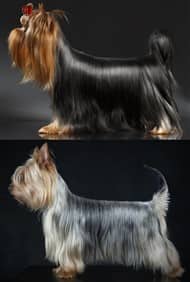

These photos show the more varied shading in the Silky’s coat (right; bottom on mobile) with
lots of intermingling in the colors. On the other hand, with the Yorkie (left, top on mobile),
the bands of steel-blue are more solid.
Coat Type Comparisons
You may have guessed from its name that despite the fact that the Silky Terrier has the Australian Terrier’s rough coat in its bloodline, the texture of its coat is nearly identical to the Yorkshire Terrier’s; both have very soft and silky hair. And, both have straight hair.
Per AKC’s breed standards, the Yorkie’s coat is ‘... glossy, fine and silky in texture.’ And '... perfectly straight, not wavy'.
And, the Silky’s coat is ‘Straight, single, glossy, silky in texture'.
If you’re wondering about coat length, both breeds are capable of growing long coats (despite what you may have read elsewhere). However, in the show ring, the Silky Terrier is expected to have a shorter trim.
Per AKC guidelines, the Yorkie’s coat is, '...moderately long... It may be trimmed to floor length to give ease of movement... Hair on muzzle is very long. Hair should be trimmed short on tips of ears and may be trimmed on feet... '
This is quite different than the Silky’s coat that '... falls below and follows the body outline. It should not approach floor length.... long hair on the face and ears is objectionable. The feet should not be obscured by the leg furnishings.'
It should be noted that the FCI (Federation Cynologique Internationale) with 90+ member countries veers from this for the Australian Silky Terrier with ‘The length of coat must not be so long as to impede the dog’s action and should allow daylight to be seen under the dog.’
Since both breeds have a single coat of hair (not fur), using top-quality shampoos and coat products
is an important part of coat care and can help avoid common issues like skin reactions, itching, and hot spots.
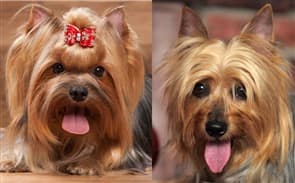
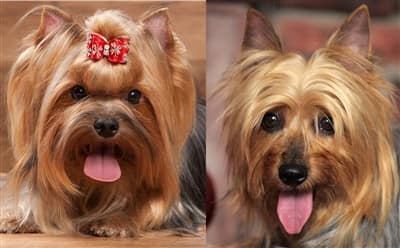
Popularity
In the US, the Yorkshire Terrier is much more popular than the Silky Terrier.
The AKC has the Silky Terrier currently ranked at #106. There has been a steady decline in popularity. This breed was #29 in 2006. Jumping ahead to 2013, the Silky ranked at #92.
The Yorkshire Terrier, on the other hand, is ranked at an impressive #9 by the AKC, though there has been a drop in popularity as well, just not as dramatic. In 2006, the Yorkie ranked at #2. In 2013, this dropped a bit to #6.
Personality
Appearance aside, the Yorkshire Terrier and the Silky Terrier are very much alike in regard to personality.
Though the Yorkie had its start as a working dog, he stayed close to his owner’s side which made the transition to companion lap dog rather easy.
The purpose of developing the Silky Terrier was to create a new companion lap dog, though with both of its parent-breeds (Yorkshire Terrier and Australian Terrier) being ratters, it may be no surprise to hear that the Australian Silky Terrier gain a reputation for chasing after snakes.
With chasing and hunting in their bloodlines, both breeds are known for being very alert and lively. And, with many generations of being revered lap dogs, both are also very affectionate and loving.
In addition, though their small size and delicate features make both indoor dogs, it is despite their diminutive stature that both are very active and energetic and are rarely happy if not taken outside for brisk walks and a bit of exploring on a regular basis.
You May Also Like:
Yorkshire Terrier Safety
- Read the top 10 things you can do to keep your Yorkie puppy or adult dog safe at all times.
When a Yorkie Rubs Their Bum on the Ground
- The top reasons that dogs do this and steps to take if your little guy or gal displays this behavior.
When a Yorkie Eats Grass
- If your little guy or gal grazes on grass, you'll want to read this article. This covers why dogs do this, if there are any negative consequences, and exact steps to stop this behavior.
Yorkie Bad Breath Issues
- Learn why this is so common and steps you can take to resolve this.
How to Fix Dry Skin on a Yorkie
- There are several factors that can cause this breed's sensitive skin to dry out and it's best to resolve this before it spirals into bigger problems.
Keeping a Yorkie Safe Outside
- An article that answers all of your outdoor-related questions.
Fun Safe Ways to Carry a Yorkie
- From backpack-type bags to totes and slings, see some great ways to take your Yorkie with you to all sorts of places.
All content is protected by US and International copyright laws. All rights reserved.
We are a participant in the Amazon Services LLC Associates Program, an affiliate advertising program designed to provide a means for us to earn fees by linking to Amazon.com and affiliated sites. As an Amazon Associate, we earn from qualifying purchases.
